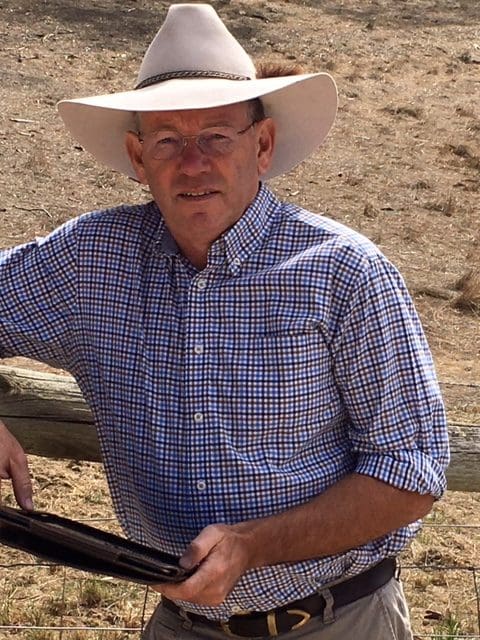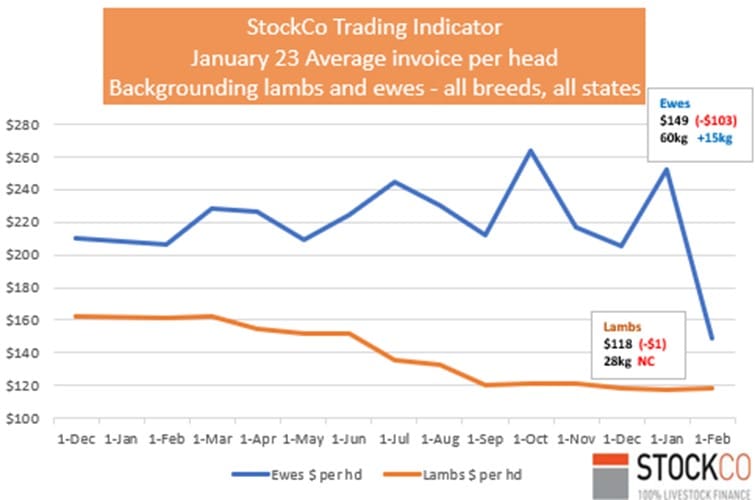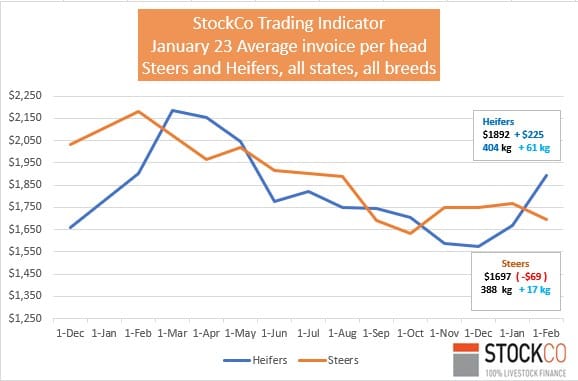
StockCo national business development manager Chris Howie.
WE have seen a significant price reset on mutton, lamb, cattle and goats.
Was this reset unexpected? Probably not, continued rain drew many to the conclusion prices might stay up for another season.
The issue with the speed of the reset is many who would normally be buying stock, stopped, because of a falling market, grain harvest was good and contracts being delivered into were still at the old price. Those that were prepared to buy on a falling market have continued to average down instead of jumping in when the prices bottom and start to move up again.
The lack of store orders for lambs and feedlot orders for feeder cattle meant every sale since mid-December has been very reliant on local support. In turn, this meant quite a wide variation in prices across all livestock. What did stand out was that quality sells, weight for age was a winner this year and weaning calves paid off.
It is in the nature of producers to say when prices are high: “They are here to stay.” We have seen it across wool, wine, beef, lamb, and grain in the last five years. All are looking backwards at what they could have done by taking a forward contract and what it would be worth. As a counter balance, it is the nature of feedlots, live export and processors to talk the market down for as long as possible. That’s not a bad thing; it’s just business.
The positive was the reset was fast and clinical, allowing buyers to gain confidence to step back into the market quite quickly, although this has still taken nearly six weeks. Those that have acted early purchased plenty of weight at the right money with many operating on a dollar limit when buying.
Many caught without a contract
The reset meant a good number of people were caught without a signed contract. Mobile phones have made “booking them in” easy and then moving on to the next job. Not only does a signed contract cover arses on price and numbers, it also lets administration staff process with the details instead of a sale yard guess. With scanners on your phone now it is very easy to send a copy to the buyer and/or vendor. Make sure you send the terms and conditions as well.
Sheep and lamb trading opportunities exist
Old ewes (mutton) took a pounding in December with most trading at $60-$70, irrespective of weight and wool length. We are just starting to see some small gains, but the trading opportunity still presents for a Winter supply spin.
The larger lines of well-bred 3–5 year-old ewes sold for joining ranged between $100-$180 and young ewes closer to $200 than $300.
With pastoral shearing starting now, some significant lines of ewes and wethers will start to be offered for sale.
Shedding sheep prices have softened a little, but are still providing great returns for breeders who have put the effort into making them as clean as possible. Following the past year many very traditional wool enterprises are starting to look hard at this option.
With lambs, the best heavies are pushing $8/kg on lack of supply, but once under 24kg cwt this price falls away quickly. Second cross store lambs are very buyable between $110-$130. Second grade woolly lambs are becoming difficult to sell. Again, Merino lambs offer value at $50-$80. Merino wether lambs are the most undervalued money spinner available at this point of time and well worth considering over the next two months.

Rain and flood issues abound
We have seen a significant impact on livestock drinking stagnant water since early December. I won’t go into the science, but many lambs once sick from drinking ‘black water’ do not recover. Cattle are not immune to this either, especially PTIC stock. Managing stock water is a difficult task but the time invested will save you considerable heartache. None of us like drinking stale beer or hot wine – sheep and cattle are the same with water.
New South Wales remained dry for over six weeks, and demand and prices suffered. Although good rain has fallen between Wodonga and Wagga, with reports of 100mm-plus. Further north 15-20mm over a couple of events has given hope there is more to follow.
The Kimberley flood event is still yet to be fully appreciated, one source said. The calving had been very good with calves carrying plenty of weight. Like the big Queensland flood, it will be very hard to estimate numbers lost, especially the calves uncounted.
Withholding periods (WHP) and Export Slaughter intervals (ESI). The use of various treatment to control flies, midges and mosquitoes on cattle and sheep pre-Christmas was an absolute requirement in many areas. Many of you may not have had the need to use these treatments in the past and if so it is important you understand the WHP & ESI timeframes when selling, as getting it wrong can be very costly. Make sure you check before consigning stock to processors or saleyards.
Steers hit by correction, but heifers shine
Steers bore the brunt of the correction, with cows not far behind. At the end of the January weaner sales most steers were ranging between $4-$5.20/kg, with the odd sale a little better. The sales softened as they progressed. Weight was the winner, with many lighter calves becoming very buyable.
Heifers were a shining light, with well-bred straight runs drawing solid breeder attention and trading very close to last year’s values. Cows were as expected and came back into the mid-$2/kg range liveweight.
Speaking to several producers, if we take the “huge price win” of 2022 out, current prices are still very good when compared to 2021 which we all thought was wonderful. Even paying ourselves agistment at $15 a week a calf is still returning close to $1000, they said.
American cow herd and drought impact. The USDA reports the US herd now is heading toward historically low beef cow numbers estimated to be 28.86 million beef cows in 2023, from a peak number of 35.3m cows in 1995 and 31.6m cows in 2019.
I’ve been following the Oklahoma National Stockyards Company sale reports on Facebook. The Winter numbers are slowing, dramatically dropping from 10,000 a week to 2750 this week. Storms, cold rain, sleet and road closures have impacted logistics over a considerable area. It seems rain is starting to impact the drought supply, with prices beginning to rally and move up, and good demand for feeders reported.
All of these moving parts do bode well for Australian supply as US prices lift and their supply starts to fall. If they can get a bit more rain a real supply hole will start to appear in about 130 days as cheaper cattle exit feedlots and purchase prices go up. This would be exactly what we saw at the tail of our last drought.
On our end, we need to make sure processors can obtain enough employees to process the Australian turnoff.

Around the traps
Cade Ebdon, AWN Tasmania, said the dry January was much needed after a long, wet and cold spell. Plenty of feed although much is tall and rank now. Lambs have struggled to gain weight with improved interest in the past seven days for lambs over 24kg dressed. Light lambs and mutton are still trading at reduced rates. AWN will start with the first weaner sale at Powranna on the 23rd Of February offering just under 2000 cattle.
Geoff Shipp, Elders Muchea, said Western Australia has been very quiet on livestock. A large grain harvest and limited live export of sheep and cattle have taken much of the bite out of buyers. Weather has been very liveable in the west and the weaner sales performed at levels not much different to the eastern states. Quality cattle are becoming short in supply with competition on mutton and secondary lambs the same as everywhere else. Muchea will run a weaner sale on the 15th of February with around 2000 head.
Andrew Peadon from Barlow & Peadon Schute Bell at Dubbo told me the area has had storms followed by up to 20mm of rain last week that has freshened the country with a green tinge showing. In Dubbo’s yarding of 14-15,000 lambs and 6-7000 mutton, heavy lambs were a little easier, tradeweights were fully firm and mutton rose $5-$7/head. Cattle yardings have only been around 1500 head, but with kids back at school a lift in numbers is expected. First cross ewes have been difficult to sell, with most of the repeat buyers impacted by last year’s floods.
HF Richardson principal Will Richardson based in Geelong and Ballarat said the majority of the heavy calves are gone from the south now, with a few Spring calvers being weaned. Vealers have started to go off, with some areas drying out quickly after an extended wet. Feeder backgrounders and bullock fatteners took advantage of the buy price. Some cattle from last year will need to be targeted into the Winter market. Will and I agree we may have hit the price bottom now on the restockers.
Southern bull sales are ready to roll. It will be interesting to see how they fare, but I think most producers have seen the benefit of investing in herds and the values will hold onto last year’s rates. Considering estimates that the Australian herd has grown 4.5 percent on last year, we are now moving into a growth stage more bulls will be required.
Wool – Has shown some solid rises since the start of January with the indicator at 1356c/kg clean this week. In the mid-1990s, and again in the early 2000s, we saw a large exit from wool production due to price. Now we are looking at another exit due to lack of shearers, work load and the continued rise of shedding breeds. What I can say is that each time we saw a farm disperse its Merino flock, the next year the overdraft blew up because of no wool clip to pay for spray or fertiliser. Merinos still offer a great return to those prepared to put the time in.
On the 19th of February, Simone Dand at Wodonga TAFE has another group starting their Agency and Supply chain training. This has had a great endorsement from the agency community, with RMA Network (Rural Marketing Agents) co-funding any member participants. With support from AuctionPlus, StockCo and numerous industry specialists, the upskilling opportunity is being noticed across all states. There are still three spots available with a cap of 15.
Young staff – yearly reminder. They are keen and fresh but not used to the long hours. Most aren’t fully weaned. Remember their emotional tank will run dry at about 5-6 weeks. Don’t blow up, support them and in most instances, you will be well rewarded.
Opportunities
Mutton – put out for winter
Merino lambs – value for money
Cows and calves – freshen and split
Heifers to join
Trading opportunity is here
Grain feed some lambs
Do the sums on custom feeding some of your home-bred cattle.
Training with Simone at Wodonga TAFE
Get your livestock finance in place now
Get contracts completed and signed

Appreciate your vast knowledge, which is backed by direction to livestock industry.